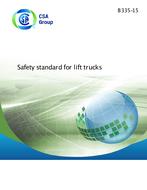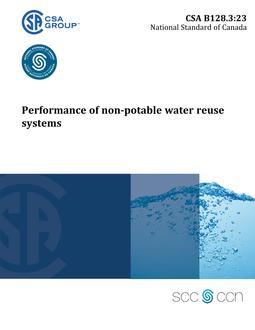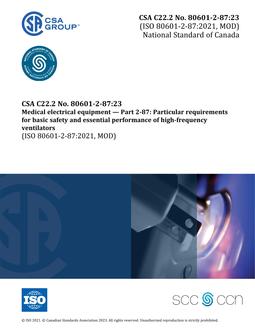
CSA B335-15
Click here to purchase
Preface
This is the third edition of CSA B335, Safety standard for lift trucks. It supersedes the previous editions- published in 2004 and 1994. This Standard specifies the key elements of a lift truck safety program and also provides recommended qualifications for lift truck trainers and maintenance technicians and personnel.
This edition of CSA B335 has been updated and harmonized with design, classification, and maintenance requirements of ANSI/ITSDF B56.1 and ANSI/ITSDF B56.6. The following significant changes and additions have been made over the requirements and guidance in the 2nd edition:
a) new references to CSA OHS management standards (Z1000 series), CSA A344.1 Guide on Use of Steel Storage Racks, CSA Z460 Standard on Hazardous Energy Control, and CSA Z462 Standard on Workplace Electrical Safety;
b) expanded requirements for facility design (Clause 4.5.5.1);
c) enhanced requirements for aisleways and management of obstructions (Clause 4.5.6);
d) further direction on the selection of lift trucks for the intended application (Clause 4.6.1);
e) enhanced requirements for operator compartment guards (Clause 4.8.4.3);
f) more explicit requirements for pre-operation inspections (Clause 4.9.1 and Annex A);
g) guidance on conducting risk assessments (based on CSA Z1002);
h) modified requirements for load handling (Clause 4.9.5);
i) new requirements for supporting of trailers entered by lift trucks (Clause 4.9.7.3);
j) expanded requirements for use of a lift truck to elevate personnel (Clause 4.9.9);
k) more explicit requirements for “leaving the operator’s position” (Clause 4.9.12);
l) simplified requirements for medical and physical fitness of operators (Clause 4.10);
m) ergonomic design considerations (Clause 5.3 and Annex C) now reference CSA Z1004;
n) operator training requirements (Clause 6) now reference CSA Z1001;
o) numerous modifications have been made to the training requirements to correspond with changes made to the operation, safety, inspection, and maintenance requirements throughout the Standard;
p) changes have been made to the retraining requirements (Clause 6.21);
q) additions have been made to basic operator qualifications (Clause 6.22);
r) hazard energy control requirements for maintenance work now reference CSA Z460 (Clause 8.1.6);
s) enhancements have been made to requirements for pre-operation inspections and service report inspections (Clause 8.2);
t) new guidance on battery charging (Annex D); and
u) new example Operator Evaluation Forms (Annex F).
Scope
1.1
This Standard applies to Class 1, 2, 3, 4, 5, and 7 powered lift trucks – their design, operation, and maintenance. In addition, certain clauses apply to Class 6 vehicles, non-powered high-lift trucks, and personnel and burden carriers. See Annex B for a listing and description of classes.
1.2
The purpose of this Standard is to promote lift truck safety and minimize the risk of injury to workers by specifying the essential elements of a lift truck safety program and prescribing requirements with respect to lift truck design and construction, maintenance and inspection, safe operation, and operator training.
This Standard also outlines recommended qualifications for trainers and maintenance technicians.
This Standard can also be used as a guide for Canadian federal, provincial, and other regulatory bodies in the development and promulgation of appropriate health and safety legislation and directives concerning lift trucks.
1.3
Clause 4 of this Standard specifies the key elements of a lift truck safety program, including general medical and physical fitness requirements for lift truck operators.
1.4
Clause 5 of this Standard sets forth safety standards for the design and construction of lift trucks at the time of manufacture.
1.5
Clause 6 of this Standard provides minimum requirements for initial and ongoing familiarization and upgrade training in the operation of lift trucks, including any of their attachments.
Notes:
1) Due to the different design of vehicles classified as Class 6, non-powered high lift trucks, and personnel and burden carriers, only certain parts of Clause 6 will be relevant; however, appropriate training for these classes is to be provided to operators of said equipment.
2) Job and/or familiarization training of lift truck operators for particular lift trucks requiring special needs or specialized equipment and/or used in a specific workplace environment are in addition to the basic training requirements of this Standard.
1.6
Clause 7 of this Standard outlines the minimum qualifications for a trainer delivering a lift truck operator training program as outlined in Clause 6.
1.7
Clause 8 of this Standard covers inspection, maintenance, and repair of lift trucks and their attachments.
1.8
Clause 9 of this Standard outlines the minimum qualifications for a maintenance technician inspecting and maintaining a lift truck as outlined in Clause 8.
1.9
The values given in SI (metric) units are the standard. The values given in parentheses are for information only.
1.10
In this Standard, “shall” is used to express a requirement, i.e., a provision that the user is obliged to satisfy in order to comply with the standard; “should” is used to express a recommendation or that which is advised but not required; and “may” is used to express an option or that which is permissible within the limits of the standard.
Notes accompanying clauses do not include requirements or alternative requirements; the purpose of a note accompanying a clause is to separate from the text explanatory or informative material.
Notes to tables and figures are considered part of the table or figure and may be written as requirements.
Annexes are designated normative (mandatory) or informative (nonmandatory) to define their application.
Product Details
- Edition:
- 3rd
- Published:
- 01/01/2015
- ISBN(s):
- 9781771398237
- Number of Pages:
- 82
- File Size:
- 1 file , 3.7 MB
- Product Code(s):
- 2423407, 2423753, 2423407, 2423407


